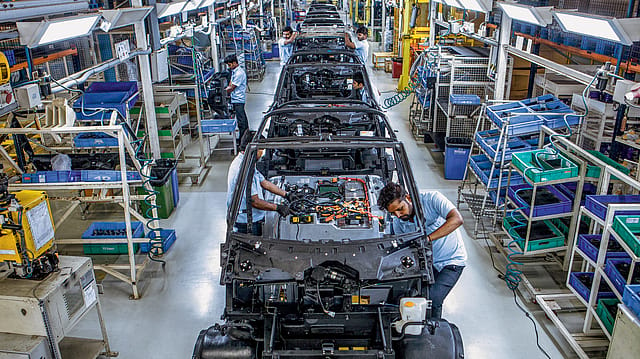India’s EV adoption accelerates in May, while Ola Electric’s decline deepens amid rapid auto market shift, report reveals
ADVERTISEMENT

India’s auto market is in the throes of a transformation, one which is increasingly led by electric mobility and shifting consumer demand across regions and segments, revealed a recent sectoral report by brokerage firm Equirus Securities.
According to the report, electric vehicle (EV) adoption accelerated in May, especially in the two-wheeler and three-wheeler segments in May. More importantly, the month also saw the country’s largest automakers fending off rising competition and evolving customer expectations.
Sales of electric two-wheelers jumped 30% year-on-year (YoY) to nearly 100,000 units last month, pushing EV penetration in the segment to 6.1%, up from 5.0% a year earlier. The surge was driven in part by North India’s wedding season demand and sustained growth across all regions.
In this regard, TVS Motors maintained its pole position for the second consecutive month, capturing 24.5% of the market, buoyed by network expansion, strategic price cuts, and improvements in battery capacity across models. Closely following on the TVS Motors, was Bajaj Auto , whose market share stood at 21.7%, while Hero MotoCorp , which was once a laggard in the EV space, continued to make quiet gains, pushed by the success of its affordable offering, Vida V2.
In stark contrast, Bhavish Agarwal’s Ola Electric , which was once in the commanding lead, saw its gains crumble. The company, which held a 48.3% share in May 2024, saw sales tumble nearly 50% year-on-year, leaving it with just 18.4% of the market in May 2025. The company began deliveries of its new Roadster X electric motorcycle last month, but whether it can regain its lost footing remains uncertain.
December 2025
The annual Fortune 500 India list, the definitive compendium of corporate performance, is out. This year, the cumulative revenue of the Fortune 500 India companies has breached $2 trillion for the first time. Plus, find out which are the Best B-schools in India.
Meanwhile, electric three-wheelers (E3W) are fast becoming the default. E3W penetration hit 63% in May, up from 56% a year ago, while CNG’s share continued its downward spiral, slipping to 23% from 30% in May 2024. E-auto sales surged 52% to 16,500 units, led by Mahindra & Mahindra (M&M) and Bajaj Auto, both of which now share the top spot with 38% market share each. Bajaj’s electric auto, introduced in June 2023, has quickly scaled, while Piaggio’s presence continues to erode—now holding only 6% of the market, down from 20% two years ago.
“M&M remains the dominant player in the e-auto market, holding a 40% market share in May’25. After a period of consistent decline, the company has now stabilised its market share at around 38-40% range over the past few months,” Equirus noted.
Coming to the passenger vehicle (PV) segment, the story is more mixed. Overall retail sales declined 3% year-on-year, with gains in the North and East offset by declines in the South and Western-Central regions. However, beneath the topline numbers, key structural shifts are underway.
Electric car sales leapt 55% to 12,400 units last month, lifting EV penetration in PVs to 4.1%, from just 2.6% a year ago. The surge was powered by high-profile launches like M&M’s BE 6 and XEV 9E, and Hyundai ’s e-Creta. JSW MG Motors’ Windsor model helped the company nearly double its market share to 31%, while M&M itself expanded its EV footprint to 21%, up from just 7% last year.
Yet, the biggest story may be the stumble of Tata Motors . Once the undisputed leader in the electric car space, Tata’s market share dropped to 35% in May 2025, from 66% a year earlier, as it struggled to hold ground amid the wave of new entrants and refreshed product lines, according to the report. The company is hoping that the recently launched Harrier EV can help reverse the slide.
CNG vehicles are also making inroads in PVs, accounting for 20% of the market, particularly in states like Bihar. Petrol vehicles, once dominant, now account for less than half the PV market for the fourth consecutive month.
Maruti Suzuki ’s overall PV share remained under 40% for the fourth straight month at 39.3%, while M&M crept up to 13.8%, surpassing Tata’s 12.2%.
Even as traditional fuel-based models continue to dominate volumes, the growing acceptance of electric and alternative fuel vehicles signals a pivotal transition. For legacy players, the challenge ahead is no longer simply growth—it’s relevance in a market that’s rapidly rewriting the rules.
